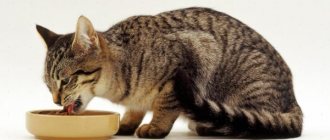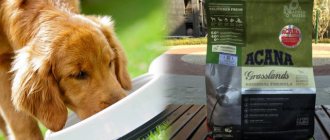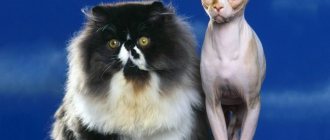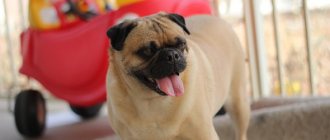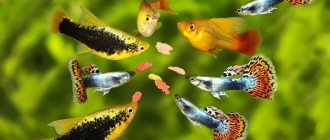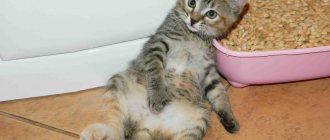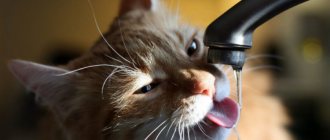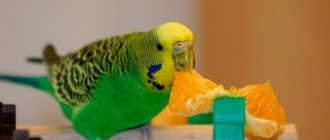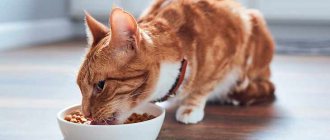Food selection
A comparative table of natural and ready-made food will allow you to evaluate the advantages and disadvantages of each type of feeding (on a mobile device you can scroll the table horizontally with your finger):
| Natural food | Ready-made feed | |
| Advantages |
|
|
| Flaws | Take a lot of time. It is necessary to carefully think through the menu, purchase food regularly and prepare food. If you cook for several days, you will have to spend time reheating. |
|
Natural nutrition - pros and cons
Before buying a kitten, you need to find out what the owner-breeders fed it. This is very important, because the baby may persistently refuse unfamiliar food. This behavior often leads to exhaustion. Kittens are real conservatives when it comes to feeding.
If the breeders have accustomed the pet to natural products, it is advisable to continue their endeavor. There are positives and negatives to a natural diet that should be carefully considered.
Natural food should be close to the natural food of cats living in nature. Basically, the diet of wild animals consists of mother's milk, meat (mice, poultry), bird eggs, fish, and grass. Cereals, vegetables, and fruits enter the body by accident; cats occasionally try them out of hunger or curiosity.
At home, you should stick to a natural diet:
- Meat dishes - prepared from chicken, turkey, veal/beef. Under natural conditions, cats eat raw meat products, but there is a high risk of infection with helminthiasis. Therefore, it is recommended to feed your pets with pre-boiled meat. As a last resort, the meat is frozen and doused with boiling water before serving.
- Eggs are rarely present in the diet. It is enough to feed the cat 1-2 times every 7 days with quail eggs. From chicken, animals are given only the yolk, but it is better to exclude the protein, as it can cause allergies.
- Fermented milk products help normalize the digestive process, so veterinarians advise including them in the diet. Cottage cheese, kefir, and yogurt are given separately from other dishes. You can offer these products to kittens who constantly want to eat.
- Almost all raw fish To prevent the baby from being injured by sharp bones, the fish is cleaned of the spine. To get rid of small bones, boiled fish is passed through a meat grinder.
- Kittens are allowed to give boiled liver, heart, and kidneys in small portions . In large quantities, these foods cause stomach upset, so they should be limited.
- You can’t feed them with porridge alone, but you can add chopped boiled cereals to the meat . It is necessary to take into account that meat should make up at least 70% of the total food.
- Meat pate can be prepared with boiled chopped vegetables . Vegetable supplements improve the digestive process and improve bowel movements.
- If a cat goes outside for a walk, he can find grass on his own and chew it.. For pets who do not go outside at all, grass can be grown at home. You can buy seedlings at a pet store.
It is prohibited to feed sphinxes natural dishes from the human table. Salt, sugar, preservatives, and spices are added to foods consumed by people. Cats do not need such supplements, so it is harmful for them to eat sausage, sausages, canned meat and fish. Fried foods are also harmful. The main list of prohibited products includes the following:
- fried cutlets;
- pork in any form. Raw is fraught with helminthiasis, and boiled is too fatty and heavy for the stomach;
- sausages, sausages, sausages;
- chicken bones;
- smoked meat products;
- buns, candies, cookies, sweets;
- stewed meat, canned fish. They contain too much salt and spices that are harmful to your pet’s health;
- fresh milk. Many adult pets develop lactose intolerance, so it is better to avoid milk. It is replaced with fermented milk products, which have no less health value.
IS IT POSSIBLE TO FEED THE SPHINX FROM YOUR TABLE?
In theory NO . But, unfortunately, in practice, people often feed their pets any food from the table, as well as foods that are harmful to their health.
Sphynx cats, unlike other cats, are practically omnivorous; they can eat sweets, fried meat, fruits, vegetables, plants, including poisonous ones, etc.
At the same time, sphinxes love to eat, this is due to their physiology; due to the lack of fur, they have to expend more energy for heat exchange, and this requires more calories.
Any competent breeder of purebred cats will explain that in cats of pure blood, digestion works differently than in their street, mongrel brothers. That’s why a proper diet is important.
What does a typical cat eat?
- Mice and birds, the meat of which forms the protein basis of the food, and the grains present inside the caught victim form the carbohydrate basis. By-products are presented in nature in their pure form; it is not for nothing that special gourmets eat out the insides of victims, leaving the skin, bones and other components intact.
At home, it is quite difficult to recreate the natural balance, although it is possible.
Feeding scheme
The number of feedings depends on the age of the pet. The younger the baby, the more often he needs to be fed. For example, a baby at the age of two months is fed at least 6-8 times a day - this is normal, because he would feed on mother’s milk just as often.
From 3 months, the frequency of feedings is reduced to 5-6 times, from 6 months – to 3 times. Pets over 9 months old eat well with two feedings.
Because of their hairless skin, Sphynx cats require increased nutrition. They usually eat whatever is put in their bowl, so the owner must regulate the amount of food. Excessive passion for food results in problems with excess weight. Sphynx cats should not be overfed to avoid obesity.
Taste preferences of sphinxes
The Sphynx is an unusual, exotic breed, significantly different from other cats. The closest attention should be paid to the nutrition of sphinxes. Their life expectancy, as well as their health status, directly depends on how well the diet of these pets is chosen. Sphynx cats are omnivores and tend to overeat, so their diet should be monitored very carefully.
A distinctive feature of the Sphynx is the complete absence of hair. These animals require much more energy to maintain health and immunity than others. Sphynx dogs have an accelerated metabolism and excellent appetite.
They are indiscriminate eaters and can eat anything in large quantities. Therefore, the owner of the Sphynx is responsible for ensuring that his pet has a complete, healthy, well-balanced diet containing all the substances necessary for the proper functioning of the cat’s body.
When organizing feeding the sphinx, its owner must adhere to the following principles:
- Food should be given to the animal in doses, strictly monitoring portion sizes;
- it is important to follow a diet that will be beneficial for the animal and convenient for its owner;
- When preparing a diet, you should definitely take into account the age of the Sphynx.
In addition to the age of the animal, it is necessary to be guided by some other objective factors, such as the gender of the pet and the characteristics of its physiological state (sterilization/castration, pregnancy, feeding kittens, the presence of chronic diseases).
Feeding according to financial and physical capabilities
Creating a natural menu on your own is quite a complicated matter. Therefore, it is recommended to contact a veterinarian who can calculate the amount of necessary products for each cat. Before making a choice in favor of natural products or industrial feeds, you need to evaluate your own strengths:
- For meat, fish, eggs, you need to often go to the store, and it is enough to purchase ready-made food 1-2 months in advance. If you have time to visit grocery stores and markets, you can safely introduce your baby to natural dishes.
- The lifestyle of animal owners plays an important role in the choice of diet. For example, if the owners are often away from home (business trips, courses, studies, travel), will neighbors or relatives boil meat for the cat, pick bones from fish, or prepare a healthy pate from liver and vegetables? Of course not, so it is better to accustom the kitten to ready-made food. What if you take your pet with you to the resort? On the road, the pet will find itself without food, and when it arrives at the seaside, the owners are unlikely to want to cook and bake meat and fish. Accordingly, the conclusion suggests itself: industrial feed in this situation is the best option.
- If you make a choice in favor of natural nutrition, you must remember that to saturate the body with vitamin and mineral components, it is raw foods that are required. In nature, cats do not boil mice, and they eat freshly caught fish. If you cook meat, some of the essential vitamins and minerals will evaporate, so how will your pet replenish its reserves? When choosing between raw and boiled food, you need to understand what is more important: vitamins and minerals or the risk of infection with worms. Using dry or canned food from a pet store may not be as beneficial for the body as natural food, but it allows you to calculate the amount of incoming microelements, and is also safe in terms of helminth infection.
Recipes for natural delicacies
You can pamper your pet sphinx by preparing the following “yummy”:
- Lightly boil chicken meat (1 kg) so that the top is cooked and the inside remains raw. Pass the meat together with cartilage, but without bones, through a meat grinder.
- You need to boil 2 chicken eggs. Remove the white and chop the yolk. Mix with minced meat. For the resulting amount of meat you will need to add: 25 ml of vitamin E, 50 ml of a mixture of B vitamins, 20 ml of taurine and fish oil. Mix these ingredients in 150 ml of water and pour into the minced meat. Divide the resulting mixture into single portions and store in the freezer. Before feeding, warm up to a comfortable temperature in the microwave.
A small amount of additives is mixed into the minced meat (no more than 25-30%). Chopped and boiled cereals (15%) - buckwheat, rice, egg, oatmeal - are suitable for this purpose. For variety, boiled or fresh vegetables, crushed to a puree, are added to the meat (10-15%):
- carrots rich in carotene;
- zucchini , which saturate the body with elements such as potassium, magnesium and manganese;
- fresh cucumbers . Some felines love them very much because they are very watery and allow you to get drunk on a hot summer day;
- pumpkin is useful both raw and boiled. Cats love to eat it even without meat. The dish is useful because it has an anthelmintic effect;
- broccoli – it contains antioxidants that slow down the aging process;
- asparagus is a vitamin plant that improves digestion due to its high fiber content;
- green beans - especially green beans contain a large supply of fiber. Cats eat it fresh with pleasure;
- celery – rich in vitamins and minerals important for a complete diet;
- melon – many sphinxes adore its taste and aroma. It is given in small portions, peeled and seeds removed.
It is rare, but it is allowed to pamper your pet with fish delicacies. For example, chopped and boned salmon is mixed with steamed rice in a ratio of 9:1 (90 g of fish will take 10 g of porridge). The mixture is diluted with boiled water to the consistency of a thick soup.
You can make oatmeal with tuna. To do this, the fish is boiled, cleaned and passed through a meat grinder. Oatmeal is added in small quantities to minced fish. All ingredients are thoroughly mixed. If you prepare for future use, you can place portions into individual containers and freeze the dish. Be sure to reheat before serving.
Sample menu by age
For kittens, it is necessary to create an approximate menu by age, since the needs of a growing body change every month. During this time, you need to decide on the type of diet and start appropriate complementary feeding.
Up to a month
In the first month of life, the kitten must feed on mother's milk, with which it receives antibodies to form strong immunity. It also helps to balance the colonization of the intestines with microflora.
If natural nutrition is not possible, then the baby is fed artificially. For this, an industrial substitute, diluted goat's milk or infant formula is used.
Feeding regimen for kittens up to a month:
- the first 14 days - every 2 hours (10-12 times a day);
- from 15 to 30 days - every 2-3 hours with a break for sleep (8-9 times a day).
During the first month, it is better for the owner to focus on the kitten’s wishes. If he asks for food, then you need to feed him. The daily portion is from 40 to 60 ml. It depends on the size and health status of the baby.
1 month
At 1 month it is allowed to introduce the first complementary foods, which depends on the chosen diet. Products for natural menu:
- cat milk;
- goat milk diluted with warm water;
- lean meat broth;
- boiled minced meat with a homogeneous structure.
If the owner has chosen a commercial diet, then feeding continues with a cat's milk replacer or infant formula. If there is growth retardation, the kitten is given pate or mousse.
The daily portion depends on the rate of growth and development. The amount of food ranges from 45–50 g to 80–90 g. Feeding regimen is 6–7 meals, excluding liquid food (milk).
2 months
At 2 months, kittens begin to grow stronger and grow faster. Nutrition Features:
With a natural menu, liquid food (milk, broth) and minced meat remain. New products are being included: fermented milk products, chopped raw beef after preliminary freezing.
Commercial diets retain cat milk replacer or infant formula. Special canned food for kittens is introduced on an ongoing basis.
The daily portion increases to 65–100 g. The number of meals is reduced to 5–6 times, excluding milk or industrial substitute. At this age, vaccination begins, so a slight weight loss may be observed, which is considered normal.
3 months
When they reach three months of age, kittens begin to be separated into new families. This is accompanied by stress for the pet, so it is necessary to ensure a comfortable transition. It is advisable for the owner to find out what the breeders fed the baby. Innovations in diets:
- The natural menu becomes more varied and nutritious. It is allowed to introduce cottage cheese, quail eggs, raw meat in pieces, grated vegetables (carrots) or apples.
- The commercial diet is supplemented with semi-moist kitten food (pieces in jelly or gravy).
At 3 months, the serving size remains the same (70–100 g), but the calorie content and nutritional value increase. This allows you to extend the saturation period. Number of meals – 5–6 times a day.
4–6 months
As kittens approach four months of age, they begin to grow rapidly and their baby teeth change. These processes require a large amount of useful substances and nutrients. Diet changes:
- They begin to introduce more meat into the natural diet (veal, rabbit), and increase the proportion of cottage cheese. Innovations: beef or chicken offal, sea fish, omelet from chicken or quail eggs, vegetables, unsweetened fruits.
- Milk substitutes are excluded from the industrial menu, and canned food and semi-moist food for kittens are left. An important point is that the introduction of the dry product in the form of soaked granules begins.
At the age of 4–6 months, the daily portion of food increases to 100–150 g. The feeding regimen includes 4 main meals and 3 snacks. This will help the older kitten to remain with replenished energy reserves, which is what is required for sphinxes.
From 6 months to 1 year
The period from 6 months to 1 year is the time when the kitten becomes an adult. His dietary preferences are finally formed. If your pet is susceptible to allergies, it will show up. Final diet:
- The natural menu is replenished with greens and grains in cases of stunted growth, delayed development or high activity. Other products remain unchanged. The emphasis in nutrition is on meat, dairy products, and vegetables.
- The industrial menu remains unchanged until the teeth are completely replaced (canned food, semi-moist food, soaked granules). When the dentition is completely replaced, the diet includes 75% granular food and 25% wet canned food.
The daily portion depends on the size and activity of the pet. The norm is considered to be from 160 g to 220 g of food per day. The number of meals is reduced to 2-3 times.
How to accustom a cat to vegetables
Sphynxes do not really like experimenting with food, so they are gradually accustomed to new additives. New vegetables are added to meat or fish one at a time and in minimal quantities. Vegetable supplements are administered no more than once a day. After this, the cat’s reaction is noted: did he eat the entire portion with pleasure, did he have an upset stomach or vomiting after the new delicacy.
If the pet refuses the innovation, it is not recommended to insist. The next day you can try a new ingredient as a supplement. Some cats are happy to eat houseplants, but are reluctant to try vegetables. For such pets, it is recommended to purchase grass seedlings from a pet store and place them in an accessible place for germination. The cat will be happy to feast on tender greens.
In nature, animals eat grass to cleanse their stomach. Pets also need this. And although sphinxes have practically no hair, they manage to lick their shaggy friend (if the family has several pets of different breeds). Such friendly licking promotes the accumulation of fur in the stomach. Fresh grass helps clear the intestines of hairballs.
The danger of cheap feed
It is not recommended to purchase food in bulk at the grocery store. Usually, this is how they sell cheap feed mixtures that will not bring any health benefits. Chemicals and dyes found in cheap pet food cause serious illnesses, including esophageal cancer. Manufacturers indicate the presence of chemical preservatives on the labels, so before purchasing the mixture you should carefully study the composition.
Manufacturers use the term “offal” to hide waste from the meat processing industry. At best, it will be skins and cartilage, and at worst, crushed bones. If the manufacturer indicates that the food consists of by-products, it is better to refuse to purchase it. This dish does not provide any nutritional value.
Pets may happily consume such food, but this does not mean that they understand its composition. Cats are well versed in natural meat and fish, but they do not understand anything about the chemical additives that manufacturers specifically include in low-grade products. Due to odor and taste enhancers, the dish attracts animals. They are deceived by the delicate aroma of chicken or turkey, and in return they receive a mixture that is far from meat in origin.
Therefore, if you decide to feed your pet a commercially produced formula, you need to carefully study the composition. It should contain meat or fish, but not offal.
Ready-made food for the Sphynx
Veterinarians allow feeding the Sphynx with ready-made food. But you should understand that this food can only be premium or super premium. Economy class dry food will harm your pet. Breeders who preferred to give dry food to sphinxes identified only a few brands suitable for consumption:
- Royal Canin can be introduced at an early age.
- Hills.
- Inova.
- Guts choice.
- Akana.
- Eagle Pack.
The presented brands of feed contain vitamins and microelements. They are suitable as a balanced diet. Dry food is an excellent option for those owners who are absent from work or do not have time to prepare natural food. The dry option will allow the Sphynx not to go hungry, especially since the food does not spoil during the day.
The advantages of dry food include the fact that by chewing the pads, the cat cleanses tartar, thereby strengthening the gums and teeth. The disadvantages include the pet's constant thirst. Therefore, it is recommended to ensure that there is enough water in the second bowl.
Breeders' advice
Most breeders use dry food to feed their pets. But before you opt for this diet, you need to familiarize yourself with the following recommendations:
- It is not recommended to give the Sphynx cheap food. The economy option contains protein. Thus, instead of food protein, the manufacturer uses plant proteins - soy and corn. They are harmful to the Sphinx, can cause enormous harm to health and contribute to the development of cancer.
- Cheap feeds do not contain meat; instead, they put ground bones and connective tissue components, and low-quality by-products. Sphynx cats have a digestive system that is unable to digest such foods, so these components must be avoided in their diet.
- The higher the class of food, the fewer flavor enhancers it will contain. The predominance of additives in the diet will cause indigestion in the Sphynx.
- Even a small amount of low-quality food will lead to overeating of the cat. In 80% of cases, sphinxes do not digest food.
Canned food is allowed in the Sphynx's diet. They, unlike economy class, are of high quality. They are convenient to store, but they also have disadvantages. It's the price - it's too high. In addition, the shelf life after the packaging is opened is no more than a day. It is best to buy this food in small portions and give it to your pet right away.
Controlling the Sphinx is an important task for the owner. Due to the lack of wool, the Canadian representative has increased heat transfer. This is reflected in the animal’s excellent appetite. Pets spend a lot of energy, more than cats of other breeds.
They can eat almost non-stop, so you need to control this process.
Premium food
Manufacturers of high-quality food produce special mixtures for feeding sphinxes. Let's look at the most popular of them.
Orijen Cat & Kitten
The product for cats is produced in Canada. If you carefully study the label, you will find out that the food is designed not only for adult cats, but also for pregnant cats, as well as kittens.
The food has a high protein content (42%), which is necessary for purebred representatives. The cost of heating the body is compensated by the increased consumption of protein foods. Fats in the feed are present in normal quantities (20%). On mobile, you can scroll the table horizontally with your finger:
| Sources | ||
| proteins | fat | carbohydrates |
| turkey and chicken meat | Animal (chicken) fat | potato |
| bird liver | ||
| fish (pollock, herring, salmon). | ||
Additionally, the production diet includes fruit, vegetable and plant ingredients:
- apples;
- blueberry;
- pumpkin;
- turnip;
- carrot;
- green peas;
- spinach;
- chicory root;
- mint.
In addition, the food contains the daily requirement of vitamins, macro- and microelements.
Purina Pro Plan Delicate
Suitable for adult pets who are too picky about food. The composition of the feed, except for the meat part, is presented:
- rice;
- animal and fish oil;
- yeast;
- egg powder;
- green peas and corn.
The ready-made diet is rich in antioxidants, omega fatty acids and a complex of vitamins. Large dry granules help cleanse teeth and gums of plaque and tartar. Thanks to its unique composition, the food helps normalize digestion.
What to feed a kitten
Small kittens, like children, also need a certain diet that will cover the required daily intake, calories and important vitamins and substances for growth and development. However, they have a small stomach, so the portions are appropriate.
In this regard, meals are fractional. For growing organisms, they create specialized food for kittens that is completely suitable and can lie in a bowl all day without spoiling.
Directly on the package itself the daily amount of food is written based on the height and age of a small kitten, so do not neglect to read the instructions.
A substitute for dry food can be meat pates, which do not contain various chemicals, spices and salt and are, of course, designed for small animals. The obvious disadvantage is that such pates cannot be left in a bowl and divided into several times, since they quickly spoil.
To prevent obesity in a young pet, which is not uncommon in this breed, it is necessary to control the diet and portions, which should not be more than 150 grams with natural feeding.
Special diet for kittens
Bald babies require the introduction of complementary foods at the age of 1 month. They begin to feed them semolina porridge, then gradually add ground boiled meat (beef, chicken), and egg yolk. At two months, the diet is supplemented with fermented milk products (cottage cheese, kefir).
After reaching 3 months of age, the kitten’s diet can be significantly expanded. The meat should no longer be boiled and chopped; you can offer it frozen and cut into slices. The menu is supplemented with plants, vegetables and fruits.
If there is not enough time to prepare food, the kitten is transferred to ready-made mixtures (holistic, premium and super-premium categories). This could be special canned food or dry food. Before buying food, you need to carefully study the label - check the composition, date of manufacture and expiration date, as well as information about whether the food is suitable for babies. Popular brands of food for Sphynx kittens:
- Purina Pro Plan Junior Chicken;
- Royal Canin Babycat Instinctive for the little ones (up to 4 months);
- Royal Canin Kitten – for older pets (4-12 months);
- GO! Sensitivity + Shine Duck Cat Recipe Limited Ingredient Diet, Grain Free – for pets with sensitive stomachs and digestive problems.
Pregnancy and proper nutrition
Kittens need adequate nutrition while still in the womb of their mother cat. Therefore, special attention is paid to the diet of the expectant mother. It is best if the pregnant woman is breastfed. The number of daily feedings is increased to 4 times a day. The food supply is also being increased. This will prevent the kittens from going hungry.
It is necessary to take into account that an adult Sphynx pet with an average body weight of 4 kg will need at least 320 kcal. A pregnant cat needs an increased portion. During pregnancy, the norm is 1000 kcal.
The daily menu should contain raw beef (at least 50% of the diet). Supplements in the form of vegetables and grains will help protect your pet from constipation. Giving fish is not recommended. Bone meal is used as a mineral addition to dishes. It is poured into minced meat 0.5 tsp each.
Fermented milk dishes are offered separately from the main meal. For example, cottage cheese for an afternoon snack, and kefir before bed.
Sphynx food allergy
This unusual breed of cats, which always freezes, has an unpleasant feature - they are susceptible to allergies. There can be many reasons for this, including food allergies.
© shutterstock
Super premium food for sphinxes usually does not create such problems in the life of the pet and its owner, but cheaper economy class analogues and low-quality food may well be the causes of the sore.
Unscrupulous manufacturers put a lot of untested chemicals into cheap food, trying to save on costs.
Excess protein foods in the diet is another factor in favor of allergies. Sphynx owners often overuse one protein product, for example, chicken breast, forgetting about the variety of food. As a result, an allergy appears, and what’s scary is not immediately.
In most cases, identifying a food allergen can be very difficult. Some of them tend to accumulate in the body and only appear over time in the form of:
- red rash;
- itching;
- dandruff;
- moist armpits;
- otitis;
- drowsiness;
- ulcers
To get rid of allergies, you can give Sphynx cats:
- Vitamin complexes.
- Antihistamines and steroid drugs.
- Olive oil.
- Lamb meat, rice, mutton.
As a preventive measure, you can also give cats antihistamines, monitor the quality of products and the variety of diet, and choose the most natural food for Sphynx cats.
Feed replacement
Even the most expensive and elite food can cause digestive upset in a pet. Problems with bowel movements, diarrhea, constipation, and general deterioration in health indicate that the body does not accept the food offered.
The kitten becomes restless, refuses to play with the owner, and eats reluctantly. It is necessary to contact a veterinarian and have the animal examined. If no objective reasons have been identified, then the deterioration of the condition is caused by poor nutrition. In this case, it is necessary to change the food.
The change in diet is approached gradually. Choose another feed manufacturer. Add some new ones to the old granules and offer them to the kitten. Sphynxes are very sensitive to substitution and at first they can sort out their food, choosing the usual one.
The replacement process is lengthy; if the cat categorically refuses to eat the new food, it is necessary to purchase another one. This is how the trial method is used to achieve a complete replacement of nutrition. You need to be patient, because the health of the pet is in the hands of the owner.
